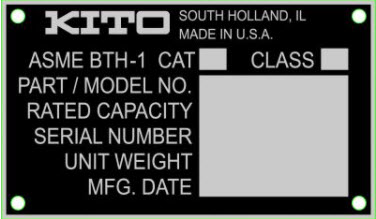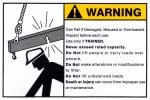BTH Safety Guidelines
Below-the-Hook & Material Handling Equipment
This information consists of general guidelines only. Refer to current OSHA, ANSI & ASME standards for complete specifications.
INDUSTRY STANDARDS
The American Society of Mechanical Engineers (ASME) developed standards that apply specifically to the devices Peerless Industrial Group, Inc. designs and manufacturers. These standards serve as a guide to government authorities, manufacturers, purchasers and operators of below-the-hook lifting devices.
ASME B30.20-2018
Provides detailed information on the classifications, marking, construction, installation, inspection, testing, maintenance and operation of below-the-hook lifting devices.
ASME BTH-1-2020
Provides detailed information on the design criteria of below-the-hook lifting devices.
MARKINGS & IDENTIFICATION


The rated load of the lifting device is visibly marked on the main structure of the device, as well as on a tag attached to the lifter. If the below-the-hook lifting device consists of individually detachable lifters, then each of the individual lifters shall be marked and tagged with their individual rated loads.
All Peerless Industrial Group, Inc. below-the-hook lifting devices are tagged with the following information:
- Manufacturer’s name and address
- Serial number
- Lifter weight, if over 100 lbs. (45 kg)
- Cold current (amps) (when applicable)
- Rated voltage (when applicable)
- Rated load
- Manufacture date
- ASME BTH-1 Design category
- ASME BTH-1 Service class
GENERAL CONSTRUCTION
All Peerless structural and mechanical lifting devices are designed and manufactured by qualified personnel. Peerless designs are in accordance with ASME BTH-1 and take into consideration the stresses that result from the application of the rated load along with the weight of the actual lifter and are designed to ASME BTH-1 Design Category B. Service Class is determined by taking into consideration the fatigue life criteria based on the expected number of load cycles.
DESIGN CATEGORY
Design category B shall be utilized when the size, scale and variation of loads applied to the lifter are not always predictable or clearly defined and where the environmental and loading conditions vary or could be severe.
SERVICE CLASS
Service Class is determined by the specified fatigue life of the lifter.
- Service Class 0 is 0 to 20,000 load cycles.
- Service Class 1 is 20,001 to 100,000 load cycles.
- Service Class 2 is 100,001 to 500,000 load cycles.
- Service Class 3 is 500,001 to 2,000,000 load cycles.
- Service Class 4 is over 2,000,000 load cycles
SERVICE CLASS LIFE
| Cycles Per Day | Desired Life (Years) | ||||
| 1 | 5 | 10 | 20 | 30 | |
| 5 | 0 | 0 | 0 | 1 | 1 |
| 10 | 0 | 0 | 1 | 1 | 2 |
| 25 | 0 | 1 | 1 | 2 | 2 |
| 50 | 0 | 1 | 2 | 2 | 3 |
| 100 | 1 | 2 | 2 | 3 | 3 |
| 200 | 1 | 2 | 3 | 3 | 4 |
| 300 | 2 | 3 | 3 | 4 | 4 |
| 750 | 2 | 3 | 4 | 4 | 4 |
| 1,000 | 2 | 3 | 4 | 4 | 4 |
All welding shall be in accordance with ANSI/AWS D14.1 and ASME BTH-1.
Exposed moving parts such as gears, projecting shafts and chain drives that constitute a hazard under normal operating conditions are guarded. Electrical equipment and wiring shall comply with ANSI/NFPA 70 and ASME BTH-1.
FOR INFORMATION ON MODIFICATIONS OR REPAIRS TO YOUR LIFTING DEVICE, CONTACT PEERLESS INDUSTRIAL GROUP TO ENSURE COMPLIANCE WITH THE CURRENT ASME STANDARDS.
PROOF TEST
100% OF ALL PEERLESS BELOW-THE-HOOK LIFTING DEVICES ARE PROOF-TESTED TO 125% CAPACITY AND CERTIFICATES SUPPLIED AT NO ADDITIONAL CHARGE.
Requirements & Recommendations:
Requirements of the ASME standard are noted by the word shall.
Recommendations of the ASME standard are noted by the word should.
OPERATION PRACTICES FOR LIFTING DEVICES
Below-the-hook lifting devices shall only be operated by the following qualified personnel:
- Personnel designated to operate the lifter.
- Trainees who are under the direct supervision of designated personnel.
- Personnel designated to maintenance and/or conduct testing on the lifter.
- Personnel designated to inspect the lifter.
The below-the-hook lifting device shall not be overloaded beyond its manufactured rated capacity nor shall it be utilized to handle any load that it was not designed to handle.
When rigging is utilized in conjunction with the lifter, the operator shall ensure that it is not kinked and the multiple part lines are not twisted around each other.
The operator shall ensure that the load is correctly distributed for the lifter prior to the lift.
The operator shall ensure that the temperature of the load does not exceed the maximum allowable limits of the lifting device.
The operator shall ensure that the lifter is moved into place over the load in such a way as to minimize swinging.
The operator shall ensure that sudden acceleration or deceleration of the load is prevented.
The operator shall ensure that the lifter and the load do not come into contact with any obstruction.
The operator shall ensure that the load is not transported over people.
The operator shall ensure that the lifter is not utilized for side pulls or sliding the load unless explicitly authorized by a qualified person.
The operator shall ensure that suspended loads are not left unattended.
The operator shall ensure that no person rides the load or the lifter.
The operation of the lifter shall be observed prior to and during a shift. Any observed deficiency in the lifter shall be examined by designated personnel. Any deficiency that constitutes a hazard shall be removed from service and tagged “Out of Service”. All hazardous deficiencies shall be reported to qualified personnel for evaluation.
All loads shall be guided in a manner to avoid endangering any part of the body as it is lowered or being accidently dropped.
Miscellaneous Operating Practices
An operator shall not utilize a below-the-hook lifter that has an “out of service” tag or has been designated as non-functioning.
Only designated personnel shall be given the authority to remove “Out of service” tags on lifting devices.
When not in use the below-the-hook device should be stored in an assigned location.
Lifter markings and tags shall not be removed or damaged. Lifter markings and tags that are missing or illegible shall be replaced.
INSPECTION
Initial Inspection:
Prior to initial use, all new, altered, modified, or repaired lifting devices shall be inspected by a qualified person to ensure compliance with the provisions of the ASME B30.20 standard.
Inspection Intervals:
Below-the-hook lifters in regular service require three general types of inspection classification procedures; every lift, frequent, and periodic. The intervals for inspection are determinant upon the severity of use of the below-the-hook device, the extent of the exposure to wear and tear, as well as any history of malfunction experienced by the lifter.
Every Lift Inspection:
A visual examination performed by the operator of the below-the-hook lifter conducted prior to and during every lift.
Frequent Inspection:
Are comprised of visual inspections performed by Either the lifter operator or other assigned personnel (Records are not required by the ASME standard).
- Normal use – once a month
- Heavy use – once a week to once a monthly
- Severe use – once a day to once a week
- Special or infrequent use – outlined as specified by a qualified individual prior to and following each use.
- Any lifter that has been idle for a period of one month to a year shall undergo a frequent inspection prior to use.
The following items listed below shall be included within the regular inspection schedule and shall be thoroughly inspected and an assessment formed as to the extent of the issue and the level of subsequent hazard resulting from it.
- Structural deformation
- Cracks in welds or structural members
- Excessive wear
- Loose or missing parts, tags, safety guards, fasteners, stops, and/or housings.
- Out of adjustment conditions that interfere with the normal operation and functionality of all mechanisms including automatic hold and release components.
- Contact Peerless Industrial Group, Inc. for replacements of missing identification tags and nameplates.
Periodic Inspections:
Are comprised of visual inspections performed by assigned personnel who record the current condition of the below-the-hook lifter in order to provide the basis for a continuing program of recorded evaluation. Dated reports for periodic inspections shall be maintained.
- Normal use – annual inspection typically performed on-site.
- Heavy use – dis-assembly by a qualified individual should be performed semi-annually in order to facilitate a detailed inspection.
- Severe use - dis-assembly by a qualified individual should be performed quarterly in order to facilitate a detailed inspection.
- Special or infrequent use – outlined as specified by a qualified individual prior to and following each use.
- Any lifter that has been idle for a period of one year or more shall undergo a periodic inspection prior to use.
Below-the-hook lifting devices shall undergo a thorough inspection based upon the previously defined intervals of every lift, frequent, and periodic. Any and all issues such as the following (as listed below) shall be investigated and a conclusion made as to if the extent of the issue and to if it is severe enough in its nature to represent a hazard. Dated inspection reports of the following critical items shall be made.
- All requirements outlined within the frequent inspection process.
- Missing or loose nuts, bolts, or fasteners.
- Fractured gears, pulleys, sheaves, sprockets, bearings, chain and belts.
- Excessive wear of linkages, gears, pulleys, sprockets, sheaves, chain, belts, bearings, hardware, and other mechanical parts.
- Excessive wear at the bail or other load bearing points.
All repairs or modifications shall be documented on dated inspection reports.
MAINTENANCE:
Preventive Maintenance:
A preventive maintenance program shall be established and be based on recommendations made by Peerless Industrial Group, Inc.. It can be determined to be appropriate as designated by a qualified person to add to the maintenance program following a review of the use of the below-the-hook lifter.
Any hazards disclosed during an inspection shall be corrected before the lifting device is put back into service. Any repairs and/or adjustments shall be done only under the direction of or by a qualified person. Replacement parts shall be equivalent to the Peerless Industrial Group, Inc.’s specifications.
For more information or to purchase a copy of the standard, visit the ASME website, www.asme.org.